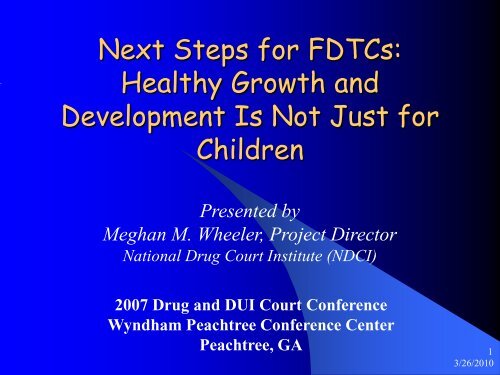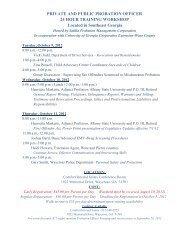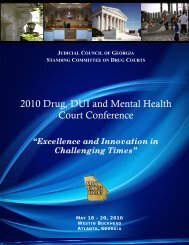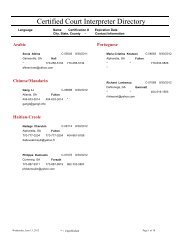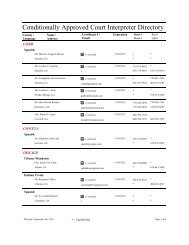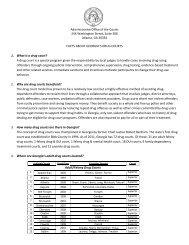Next Steps for FDTCs: Healthy Growth and Development Is Not Just ...
Next Steps for FDTCs: Healthy Growth and Development Is Not Just ...
Next Steps for FDTCs: Healthy Growth and Development Is Not Just ...
You also want an ePaper? Increase the reach of your titles
YUMPU automatically turns print PDFs into web optimized ePapers that Google loves.
<strong>Next</strong> <strong>Steps</strong> <strong>for</strong> <strong>FDTCs</strong>:<br />
<strong>Healthy</strong> <strong>Growth</strong> <strong>and</strong><br />
<strong>Development</strong> <strong>Is</strong> <strong>Not</strong> <strong>Just</strong> <strong>for</strong><br />
Children<br />
Presented by<br />
Meghan M. Wheeler, Project Director<br />
National Drug Court Institute (NDCI)<br />
2007 Drug <strong>and</strong> DUI Court Conference<br />
Wyndham Peachtree Conference Center<br />
Peachtree, GA<br />
1<br />
3/26/2010
What Does the Research Tell Us?<br />
Family Treatment Drug Court Evaluation<br />
• Conducted by NPC Research<br />
• Funded by the Center <strong>for</strong> Substance Abuse<br />
Treatment, SAMHSA<br />
• Final report is available on NPC’s website:<br />
www.npcresearch.com<br />
• Four Sites With Different FTDC Models<br />
2<br />
3/26/2010
Sample Demographics <strong>and</strong> Case<br />
Characteristics<br />
• Over 75% of families in all sites were<br />
unemployed<br />
• Over 60% were single mothers<br />
• Education leveled varied somewhat by site:<br />
– San Diego: 45% less than HS education<br />
– Santa Clara: 52% less than HS<br />
– Suffolk: 26% less than HS<br />
– Washoe: 56% less than HS<br />
• Mothers ages ranged from 28-34,<br />
• Average of 2 children per case<br />
• Over 50% of families had at least one infant<br />
3<br />
3/26/2010
Sample Demographics <strong>and</strong> Case<br />
Characteristics continued<br />
• Allegations<br />
– Vast majority of cases had neglect allegations<br />
(over 90%)<br />
• Money Spent on Alcohol & Drugs<br />
– At baseline, mothers spent an average of $98<br />
on alcohol in the 30 days prior to the start of<br />
their case (range of $3-$550)<br />
– At baseline, mothers spent an average of $649<br />
on drugs in the 30 days prior to the start of<br />
their case (range of $20-$9,000)<br />
4<br />
3/26/2010
Outcomes Summary<br />
• Strong treatment findings:<br />
– Drug court parents more likely to enter treatment, spend<br />
more time in treatment, <strong>and</strong> complete treatment<br />
• Longer time to permanent placement <strong>and</strong> case closure<br />
<strong>for</strong> drug court parents could be explained by the<br />
longer treatment stays<br />
• Primary child welfare findings:<br />
– Drug court children spend more time with parents during<br />
the case <strong>and</strong> less time in out-of-home placements<br />
– Drug court children more likely to be reunified with<br />
children at the end of the case<br />
– No differences in child welfare recidivism, but follow-up<br />
period was short<br />
• Court cases longer, but more compliance<br />
5<br />
3/26/2010
Key Questions About FTDC<br />
• Does how long it takes parents to enter<br />
FTDC relate to outcomes (time spent in<br />
treatment, treatment completion, <strong>and</strong><br />
reunification)?<br />
• Does time spent in FTDC relate to<br />
outcomes?<br />
• Do the number of FTDC appearances relate<br />
to outcomes?<br />
• Does FTDC graduation relate to outcomes?<br />
6<br />
3/26/2010
Variable<br />
FTDC Experiences<br />
<strong>and</strong> Treatment Outcomes<br />
Statistically<br />
Significant?<br />
Nature of Relationship to<br />
Treatment Outcomes<br />
Time to FTDC entry<br />
(petition to entry)<br />
No<br />
No relationship<br />
Time spent in FTDC Yes Longer stays in FTDC are<br />
related to longer stays in tx <strong>and</strong><br />
more tx completion<br />
Number of FTDC<br />
appearances<br />
Yes<br />
More FTDC appearances are<br />
related to longer stays in tx <strong>and</strong><br />
more tx completion<br />
FTDC graduation Yes Graduation is related to longer<br />
stays in tx <strong>and</strong> more tx<br />
completion<br />
7<br />
3/26/2010
Treatment Experiences<br />
<strong>and</strong> Reunification<br />
Variable<br />
(parent report)<br />
Treatment access &<br />
appropriateness<br />
Frequency of meetings<br />
with treatment<br />
counselors<br />
Statistically<br />
Significant?<br />
Yes<br />
Yes<br />
Nature of Relationship to<br />
Reunification<br />
The more accessible/ appropriate, the<br />
greater the likelihood of reunification<br />
The more meetings, the greater the<br />
likelihood of reunification<br />
Mothers who completed at least one treatment<br />
episode are more likely to be reunified.<br />
8<br />
3/26/2010
Court Observations<br />
• Observations of both drug court <strong>and</strong><br />
regular court process suggest that there are<br />
clear differences in the frequency <strong>and</strong><br />
consistency with which FTDC courts<br />
provide:<br />
– Emotional & Practical Support<br />
– Accountability<br />
– Monitoring<br />
– Parent engagement in the process<br />
9<br />
3/26/2010
Emotional <strong>and</strong> Practical Support<br />
• Parents talked about how the drug court team, <strong>and</strong> in<br />
particular the judge <strong>and</strong> the drug court-dedicated case<br />
workers provide a support system.<br />
“The drug court team <strong>and</strong> the drug court case worker have<br />
helped me a lot. My first case worker, that wasn’t the drug court<br />
one, didn’t spend much time with me, but my drug court case<br />
worker always knew what was going on with me, <strong>and</strong> helped me<br />
get what I needed to get my kids back.”<br />
• Participants in drug court receive practical assistance.<br />
Parents talked about:<br />
– how the drug court helped get them housing <strong>and</strong> employment,<br />
– helped with life improvement needs such as tattoo removal,<br />
dentures <strong>and</strong> obtaining birth control.<br />
• These practical <strong>and</strong> external supports helped to increase<br />
parents’ sense of confidence <strong>and</strong> ability to make<br />
improvements in their lives.<br />
10<br />
3/26/2010
Accountability <strong>and</strong> Collaboration<br />
• Parents also explained how frequent hearings <strong>and</strong><br />
attendance in drug court provided accountability <strong>for</strong> their<br />
behavior because:<br />
– “the team knows what’s going on with you <strong>and</strong> you get immediate<br />
support <strong>for</strong> whatever is going on as soon as you need it.”<br />
– “it’s helpful going every two weeks because things can come up<br />
during that time, <strong>and</strong> in drug court these problems are addressed<br />
quickly.”<br />
• Frequent court attendance means that the judge <strong>and</strong><br />
others are well in<strong>for</strong>med about the parents’ cases <strong>and</strong> able<br />
to provide appropriate support <strong>for</strong> recovery <strong>and</strong> other<br />
issues facing the parent.<br />
“(attending drug court regularly) helps you feel less<br />
alone, that someone knows what’s going on in your life<br />
<strong>and</strong> the all the issues that you face, they know how to<br />
support you <strong>and</strong> what you need.”<br />
11<br />
3/26/2010
Sense of Accomplishment<br />
• Parents who graduated from drug court spoke<br />
eloquently about the significance of graduation.<br />
Parents discussed how graduation from drug<br />
court gave them a sense of accomplishment,<br />
some <strong>for</strong> the first time in their life.<br />
“It (graduation) was great. Everyone applauded <strong>for</strong> me, I<br />
got a hug from the Judge, <strong>and</strong> they gave me flowers. I felt<br />
like a beauty queen. I also felt that my graduated meant<br />
that I finished something I started, <strong>and</strong> this is the first<br />
time I ever accomplished something like this in my life.<br />
Now I feel like I can succeed in life.”<br />
12<br />
3/26/2010
Judicial Characteristics<br />
• Drug court team members described the judicial<br />
characteristics they believed to be related to<br />
successful drug court experiences, such as:<br />
– Being consistent, straight<strong>for</strong>ward, <strong>and</strong> clear decisionmakers<br />
– Judges who have these characteristics help clients<br />
know what to expect <strong>and</strong> help keep clients<br />
accountable.<br />
• It is also important to drug court team members<br />
that the judge be an active member of the drug<br />
court team, which in turn encourages the<br />
collaborative nature that is so important to<br />
FTDCs.<br />
13<br />
3/26/2010
Barriers to Parent’s Progress<br />
• The two major barriers to success<br />
identified in the parent interviews <strong>and</strong><br />
confirmed in the courtroom observations<br />
are:<br />
– When parents lacked needed support<br />
– When there was an absence of collaboration<br />
between the team members.<br />
14<br />
3/26/2010
Putting It All Together:<br />
What Have We Learned?<br />
• Data strongly support the effectiveness of the FTDC<br />
model in improving both treatment <strong>and</strong> child welfare<br />
outcomes; “traditional” FTDC models may be most<br />
effective<br />
• FTDC influence on outcomes goes beyond simply<br />
improving treatment completion rates<br />
• Retention of families in FTDC programs is important<br />
to success<br />
• Quality of treatment provided is important to success<br />
• FTDC influence on child welfare recidivism needs<br />
additional data <strong>and</strong> research<br />
15<br />
3/26/2010
NDCI Technical Assistance<br />
Building Program<br />
Capacity<br />
Client Termination<br />
Criteria<br />
<strong>Development</strong> of<br />
Ancillary Services<br />
Incentives <strong>and</strong><br />
Sanctions<br />
Program<br />
<strong>Development</strong><br />
Review of Program<br />
Design<br />
Targeting /<br />
Eligibility Criteria<br />
Case Processing & Child<br />
Protection Practices<br />
Clinical Case<br />
Management<br />
Drug Testing<br />
Maintaining Compliance<br />
with ASFA & ICWA<br />
M<strong>and</strong>ates<br />
Program Sustainability<br />
Roles & Responsibilities<br />
Team Building <strong>and</strong><br />
Strategic Planning<br />
Clarifying & Improving<br />
the Scope of Family<br />
Interventions<br />
Cultural Proficiency<br />
Family Reunification,<br />
Recovery Planning <strong>and</strong><br />
Visitation<br />
MIS Evaluation<br />
Review of Effective<br />
Treatment Design &<br />
Practices<br />
Screening / Assessment<br />
Team Member Turnover &<br />
Training of New Team<br />
16<br />
3/26/2010
Working within a Parallel Universe<br />
The Court <strong>and</strong> the Participant<br />
• The creation of a drug<br />
court may be scary; we<br />
won’t know the outcomes<br />
until we are well into it<br />
• We come together to work<br />
with people we may not<br />
know, or may not have<br />
worked with be<strong>for</strong>e<br />
• We risk our time, our<br />
reputation, <strong>and</strong> may give<br />
up part of our turf in<br />
approaching things in a<br />
new way<br />
• Committing to<br />
participate in a Family<br />
Drug Court is scary;<br />
they do not know what<br />
the outcomes will be<br />
• They must work with<br />
people they do not<br />
know, <strong>and</strong> do not know<br />
if they can like or trust<br />
• They risk their time,<br />
relationships, <strong>and</strong> entire<br />
life style to change<br />
17<br />
3/26/2010
Giant First <strong>Steps</strong><br />
• The community comes<br />
together to identify<br />
<strong>and</strong> assess the need <strong>for</strong><br />
change in treatment of<br />
Substance Abusing<br />
Parents with at-risk<br />
children<br />
• Protocols <strong>and</strong> written<br />
policies are created to<br />
keep the Team on<br />
task, <strong>and</strong> to be able to<br />
measure success<br />
Th<br />
e<br />
piece<br />
s<br />
start<br />
• A problem with<br />
substance abuse is<br />
identified, <strong>and</strong> the<br />
parent is evaluated<br />
<strong>for</strong> appropriateness<br />
<strong>for</strong> this program <strong>and</strong><br />
safety of child<br />
• Policies <strong>and</strong><br />
h<strong>and</strong>books spell out<br />
<strong>for</strong> the client what is<br />
expected<br />
to<br />
com<br />
e<br />
togethe<br />
r<br />
18<br />
3/26/2010
Accountability <strong>Is</strong> <strong>for</strong> Everyone<br />
• Weekly Staffings <strong>and</strong><br />
court appearances<br />
ensure that services<br />
are provided <strong>and</strong> are<br />
working <strong>for</strong> parents<br />
<strong>and</strong> children<br />
• All Team members<br />
hear the same<br />
in<strong>for</strong>mation at the<br />
same time<br />
• Feed-back comes<br />
quickly when an<br />
opportunity is missed,<br />
or when success<br />
occurs<br />
• Progress is recorded<br />
in Court, a very<br />
public <strong>for</strong>um, within<br />
short parameters<br />
• Immediate impact on<br />
progress in the<br />
family plan is known<br />
by all at the same<br />
time - team members<br />
<strong>and</strong> other participants<br />
19<br />
3/26/2010
Learning<br />
<strong>and</strong><br />
Growing<br />
• The Team begins<br />
recognizing<br />
approaches that work,<br />
resources that best fit,<br />
<strong>and</strong> becomes more<br />
confident in its work<br />
• Team members<br />
develop knowledge of<br />
disciplines beyond<br />
their own, <strong>and</strong> com<strong>for</strong>t<br />
in their decision -<br />
making<br />
• The participant often<br />
takes several steps<br />
<strong>for</strong>ward, <strong>and</strong> some<br />
steps backward in<br />
this journey<br />
• They become more<br />
confident in their<br />
daily lives <strong>and</strong> make<br />
decisions about their<br />
future which takes<br />
them out of their<br />
original com<strong>for</strong>t zone<br />
20<br />
3/26/2010
Playing Nice in the S<strong>and</strong>box<br />
• Learning to challenge<br />
thinking of others/<br />
selves<br />
• Forming<br />
• Storming<br />
• Norming<br />
• Per<strong>for</strong>ming<br />
• Learning to<br />
negotiate/advocate<br />
with authority figures<br />
<strong>and</strong> systems<br />
• Phase 1<br />
• Phase 2<br />
• Phase 3<br />
• Phase 4<br />
21<br />
3/26/2010
Celebrating Success<br />
• Taking inventory of<br />
our progress<br />
• In<strong>for</strong>ming the<br />
community <strong>and</strong><br />
stakeholders<br />
• Celebrating publicly<br />
<strong>and</strong> privately<br />
• Celebrate themselves<br />
• In<strong>for</strong>m family<br />
• Educate community<br />
• Role-model <strong>for</strong> other<br />
participants <strong>and</strong><br />
potential clients, <strong>and</strong><br />
their children<br />
22<br />
3/26/2010
Building <strong>for</strong> Longevity<br />
• Create a sustainable<br />
system via:<br />
• Written procedures<br />
• Evaluations, reviews<br />
<strong>and</strong> participant<br />
surveys<br />
• Retreats <strong>and</strong> new <strong>and</strong><br />
advanced trainings<br />
• Eternal vigilance:<br />
“One day at a time<br />
<strong>for</strong> the rest of your<br />
life”<br />
• Support systems<br />
• Respite <strong>and</strong><br />
education<br />
• Alumni <strong>and</strong><br />
mentoring programs<br />
23<br />
3/26/2010
The Lindner Case:<br />
Sarah <strong>and</strong> Tom Lindner were married <strong>for</strong> 15 years <strong>and</strong> are now<br />
separated. They have 5 children, now all in Foster Care due to the<br />
drug <strong>and</strong> alcohol use of both parents. The children range in age<br />
from 13 to 3 years of age; the youngest child is not Tom’s<br />
biological child, but was accepted <strong>and</strong> raised by him <strong>and</strong> Sarah<br />
until Child Protective services had to remove the children due to<br />
extreme neglect, including failure to thrive of the youngest. The<br />
children have been in care <strong>for</strong> 12 months, <strong>and</strong> both parents want<br />
the children returned to them. Sarah is in drug court, but Tom is<br />
proceeding on a regular child neglect petition, <strong>and</strong> saying that he<br />
does not need the support of the FDTC. Sarah has complied as<br />
best she can, but has some serious mental health issues around<br />
chronic depression. Tom is complying with his court order, but is<br />
not supportive to Sarah at all. The children want to be reunited as<br />
a family, but get only 1 hour’s visitation per week with only one of<br />
24<br />
3/26/2010
Discussion Points:<br />
• How should ASFA timeframes be dealt<br />
with?<br />
• How do you decide which is the better<br />
parent?<br />
• What, if any, are barriers to reunification,<br />
<strong>and</strong> how do you address them?<br />
• What is the role of the Dependency Court<br />
in this matter.<br />
• What other systems need to be reviewed,<br />
as a result of this case, if any?<br />
25<br />
3/26/2010
NDCI Technical Assistance<br />
Building Program<br />
Capacity<br />
Client Termination<br />
Criteria<br />
<strong>Development</strong> of<br />
Ancillary Services<br />
Incentives <strong>and</strong><br />
Sanctions<br />
Program<br />
<strong>Development</strong><br />
Review of Program<br />
Design<br />
Targeting /<br />
Eligibility Criteria<br />
Case Processing & Child<br />
Protection Practices<br />
Clinical Case<br />
Management<br />
Drug Testing<br />
Maintaining Compliance<br />
with ASFA & ICWA<br />
M<strong>and</strong>ates<br />
Program Sustainability<br />
Roles & Responsibilities<br />
Team Building <strong>and</strong><br />
Strategic Planning<br />
Clarifying & Improving<br />
the Scope of Family<br />
Interventions<br />
Cultural Proficiency<br />
Family Reunification,<br />
Recovery Planning <strong>and</strong><br />
Visitation<br />
MIS Evaluation<br />
Review of Effective<br />
Treatment Design &<br />
Practices<br />
Screening / Assessment<br />
Team Member Turnover &<br />
Training of New Team<br />
26<br />
3/26/2010


